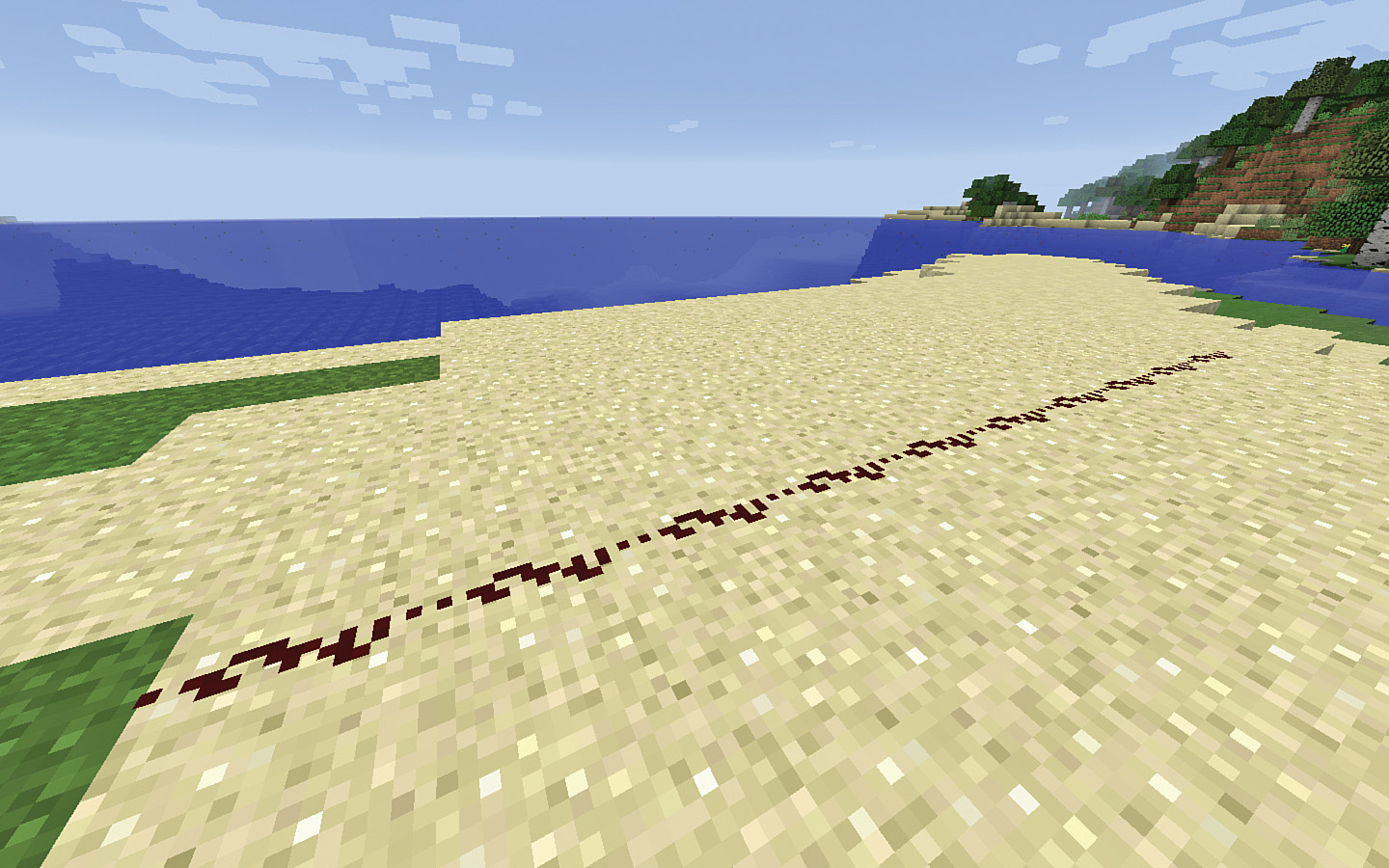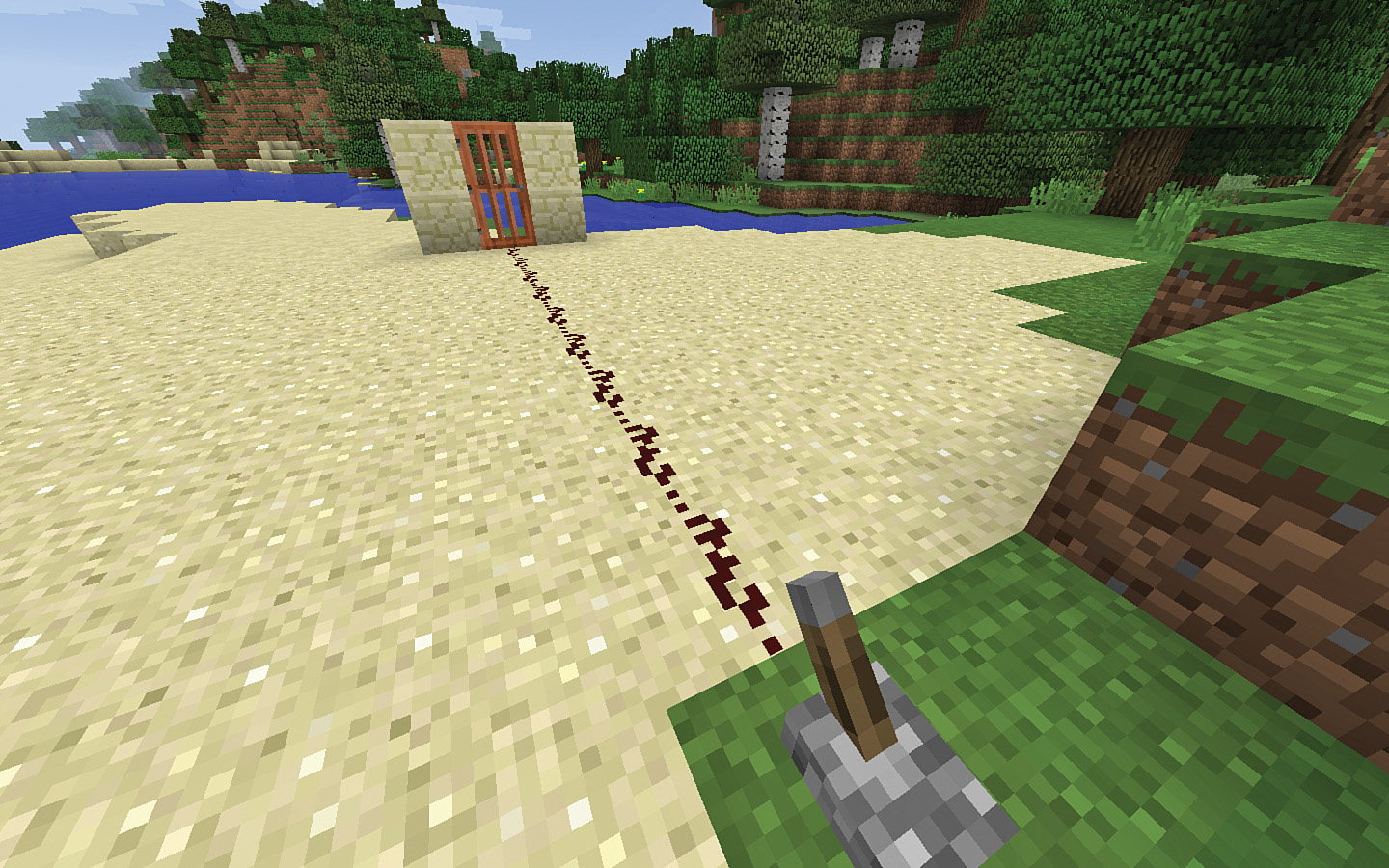B. Adding Interactive Elements With Redstone
Redstone is a standard block found in Minecraft that allows you to create automated objects. Buttons to open doors, vending machines for potions, and triggers for traps are popular items, but because redstone allows you to “wire up” creations, there’s not a lot you can’t do with a redstone block. Imagine adding controlled lighting to your castle or maybe an automatic arrow firing system to anyone who triggers a pressure plate when enemies approach your home.
This appendix provides a basic description of how to use redstone along with how to create a simple mechanism. (You might also hunt down a copy of Stephen O’Brien’s Minecraft books as he goes into a bit more detail about Redstone than I can in this appendix.)
Redstone Basics
The redstone block can be found in both Creative mode and Survival. Keep in mind that when you’re in Survival mode, redstone may be difficult to find at first and later it may be difficult to obtain in large quantities. For this reason, many of the redstone creations you’ll find online are done in Creative mode, where redstone quantities are of no concern.
Redstone blocks can be mined for redstone dust (see Figure B.1). With redstone dust and other basic items (such as a stick or an iron ingot), you can create objects like a redstone torch, a redstone repeater, or a piston. Then you can send “current” (Minecraft’s version of electricity) along a line of redstone dust to these items to power traps, doors, lights, and other features.
For more information on redstone components, visit http://minecraft.gamepedia.com/Redstone_components. To view more details, including a recipe for creating a particular redstone device, click on an individual component (such as a redstone piston).
A Simple Circuit
For one of the best online sources of information on redstone circuits, visit http://minecraft.gamepedia.com/Redstone_circuit and examine the various examples of contraptions. There are some amazing designs that can add fun capabilities to your creations. Imagine putting a lamp in each window of a castle and turning them all on at the same time with the push of a single button. Or, to prepare for a castle invasion, you can easily power a pressure plate that, when stepped on, will unleash arrows from a nearby dispenser. With redstone, you can do these things and much more.
In a nutshell, using redstone is all about moving current from one place to another. You can drop redstone dust on top of other blocks to create a path where the current can flow. Current flowing in redstone dust can go a maximum of 15 block lengths (any combination of straight paths and 90-degree turns). Also, you can use redstone components such as torches and repeaters to extend how far the dust can carry current.
Take a look at Figure B.2, and you’ll see that I’ve placed a line of redstone dust that runs 10 block lengths. At this point, the redstone dust is unpowered.
At the end of the redstone dust, I drop in a simple lever. Notice in Figure B.3 what happens when the lever is flipped: The redstone dust lights up, and little red bursts of energy are visible to indicate that current is flowing. There isn’t yet anything at the end of the line, however, so let’s change that.
After flipping the lever back to the off position, I’ve added a door to the end of the redstone line, as shown in Figure B.4. (This door is framed by sandstone blocks, but it could easily be placed between brick or quartz or any other material to act as a doorway.)
A flip of the lever causes the door to open, as shown in Figure B.5.
This is a very simple example, but I hope it’s helping you understand the value of redstone. It’s handy to be able to turn objects on and off in a Minecraft world by using redstone dust and other objects that are powered (such as doors and dispensers). Imagine hollowing out a T-rex statue and placing glowing red torches powered by redstone dust in the dinosaur’s eyes. If you created a castle in Chapter 1, “Taking Over a Castle,” and placed it in a world, consider using pistons to create a large door that opens and closes, protecting you from creepers, giant spiders, and zombies.
The uses of redstone are really only limited by your skill and imagination, so get started using redstone and see what kinds of automation you can bring to your worlds.
Advanced Redstone
Much has been written—even entire books—about redstone. If you find the subject interesting, look online, and you’ll find hours and hours of examples in videos and tutorials. Minecraft fans have built some amazing things; large computers, clocks, video games, and roller coaster parks are just a few of the crazy (and fully functional) items that people have powered with redstone.
A few resources on redstone are available in Appendix C, “Resources,” but here are a couple more for those of you who can’t wait to get started using this incredible tool:
![]() Minecraft Crafting Guide (http://www.minecraft-craftingguide.com/mechanisms.html)—This is a great list of things you can build with redstone, complete with recipes and descriptions of how the items work.
Minecraft Crafting Guide (http://www.minecraft-craftingguide.com/mechanisms.html)—This is a great list of things you can build with redstone, complete with recipes and descriptions of how the items work.
![]() Minecraft Redstone Handbook (http://www.amazon.com/Minecraft-Redstone-Handbook-Official-Mojang/dp/054568515X)—This is the official Mojang book on using redstone, and it contains excellent tutorials as well as a number of examples of using redstone to create impressive games and structures.
Minecraft Redstone Handbook (http://www.amazon.com/Minecraft-Redstone-Handbook-Official-Mojang/dp/054568515X)—This is the official Mojang book on using redstone, and it contains excellent tutorials as well as a number of examples of using redstone to create impressive games and structures.





